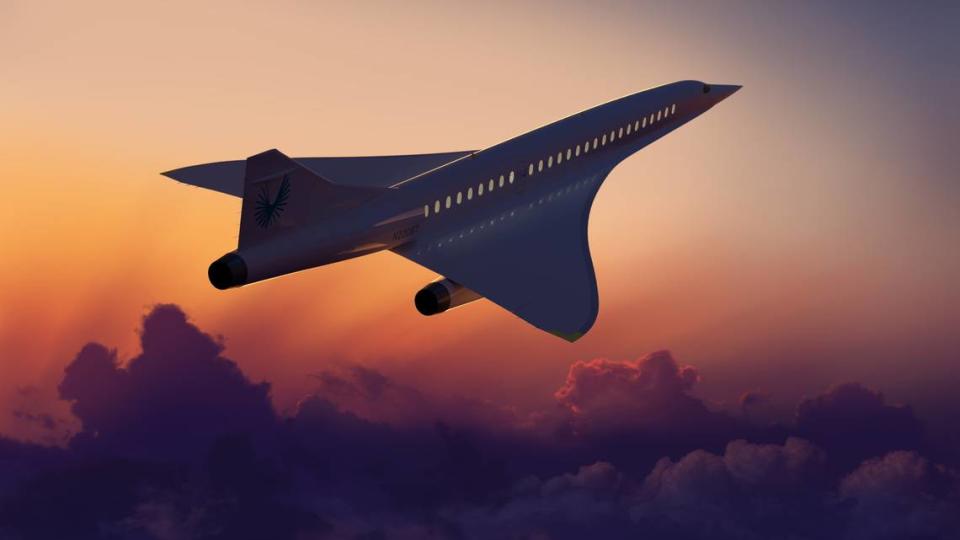Questions about Overture, Boom Supersonic’s new version of the Concorde? We have answers

Boom Supersonic, a Colorado-based aircraft developer, has plans to reinvent supersonic passenger jets — and to overcome the obstacles that ultimately grounded its predecessor, the legendary and infamous Concorde SST.
What does Boom’s supersonic offering mean for the future of travel? Are its plans environmentally and economically sustainable? And can it fly over lands where sonic booms are currently illegal?
Here, drawn from the company’s website, is a look at the technology Boom employs in its supersonic passenger jet, the Overture, plus answers to some big questions.
What’s the difference between the Concorde and the Overture?
The British Airways- and Air France-operated Concorde flew from 1976 to 2003.
But Concorde had dramatic shortcomings. The thunderous crack of a sonic boom was impermissible above populous areas, so Concorde could only fly transatlantic routes. And prohibitive operating costs made tickets inaccessible to all but the wealthiest travelers.
Still, Concorde previewed what travel could become.
“Concorde was the epitome of supersonic travel,” said a British Airways Concorde pilot, Capt. Mike Bannister. “The ability to fly at 1,350 mph, to arrive before you left, to travel faster than the Earth rotates. Sadly Concorde stopped flying in 2003, but I’ve always believed there would be a supersonic successor.”
In June, United Airlines announced it would buy 15 of Overture jets for an undisclosed price, with an option to buy 35 more. Delivery is expected in 2025, with the first passenger flight anticipated in 2029, according to a United Airlines press release.
“Boom’s vision for the future of commercial aviation, combined with the industry’s most robust route network in the world, will give business and leisure travelers access to a stellar flight experience,” United CEO Scott Kirby said in a press release. “Our mission has always been about connecting people and now working with Boom, we’ll be able to do that on an even greater scale.”
What’s the timeline?
Boom plans to break ground on a new manufacturing facility in 2022. Its first Overture planes will be complete by 2025 and in the air by 2026.
United Airlines expects to carry passengers on its Overture fleet by 2029.
What are the plane’s specifications?
The 205-foot Overture jet can fly at Mach 1.7, or about 1,300 mph — faster than the speed of sound and twice the speed of today’s fastest airliners. The plane can hold 65 to 88 passengers and fly as far as 4,888 miles at a cruising altitude of 60,000 feet.
Boom and United Airlines expect the jet can fly to more than 500 destinations worldwide, at half the current travel times.
“Among the many future potential routes for United are Newark to London in just three and a half hours, Newark to Frankfurt in four hours and San Francisco to Tokyo in just six hours,” a United press release said. “Overture will also be designed with features such as in-seat entertainment screens, ample personal space, and contactless technology.”
Can supersonic travel be environmentally sustainable?
Concorde was “notoriously unsustainable, both environmentally and economically,” Boom says on its website. “...We are leveraging more than fifty years of advancements in aerodynamics, materials, and propulsion to build economically and environmentally viable supersonic airplanes.”
Overture is designed to run on 100% sustainable aviation fuels — SAF — and will be net-zero carbon. SAF are not traditional petroleum byproducts. Instead, they are produced from biological waste oils, agricultural residues and non-fossil sources.
“Since aircraft are not able to switch to alternative energy sources (like hydrogen or electricity) in the foreseeable future, aircraft will remain to rely on liquid fuels,” according to SkyNRG, a global producer of SAF. “Therefore, sustainable aviation fuel made from renewable feedstock is one of the most important short term options to significantly reduce the industry’s carbon footprint and at the same time also reduce the dependency on the petroleum industry.”
SAF has been shown to reduce carbon dioxide emissions, improve local air quality and enhance fuel efficiency.
Can they really make the plane quieter?
Boom’s current solution to the noise of sonic boom is to avoid the problem in populous areas.
“Overture will fly at subsonic speeds over land and near coasts, so people on the ground will not be exposed to sonic booms,” the company says.
Overture will accelerate over the ocean to surpass the speed of sound.
“Passengers won’t notice when the airplane breaks the sound barrier, which will be inaudible and uneventful,” Boom says.
Takeoff and landing noise will meet the same regulatory levels as subsonic aircraft.
Is it going to be affordable?
Yes, according to Boom.
“Final ticket prices will be set by airlines, but we’re designing Overture to allow airlines to offer fares comparable to today’s business class,” the website says. “Our long-term vision is that the fastest flight is also the most affordable.”
Eventually, Boom would like to make supersonic travel available for a fraction of current ticket prices.
“Here is the future I believe in,” Boom founder and CEO Blake Scholl said. “A future in which you can get anywhere on the planet in four hours for just a hundred bucks — a world in which the fastest flight is also the cheapest and there’s no reason ever to board a slow plane. That is what we mean when we talk about making the planet dramatically more accessible.”

 Yahoo Finance
Yahoo Finance 